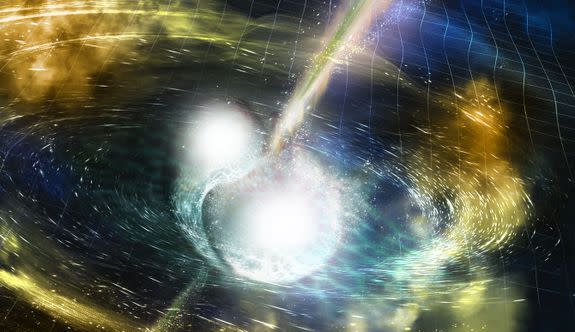Groundbreaking gravitational wave discovery shows Einstein's brilliance yet again

Even 100 years after the fact, Albert Einstein is still getting his due.
On Monday, more than a thousand astronomers and physicists around the world celebrated the announcement of a landmark discovery. For the first time, researchers saw the immediate aftermath of the merger of two neutron stars — leftover stellar remnants packed with more mass than our sun but with the diameter as small as the city of Boston.
SEE ALSO: Researchers watched as gold was made millions of light-years from Earth
Researchers detected both the ripples in space and time sent out by the colliding neutron stars as well as the light signature from the event. This marks the first time a cosmic collision has been seen in both light and gravity.
It also represents another passing grade for Einstein's general theory of relativity, which he developed in 1915.

On the morning of August 17, the two LIGO detectors in Washington and Louisiana, as well as the Virgo detector in Italy, felt the subtle distortion of the fabric of space and time caused by the ripples — or gravitational waves — sent out by the colliding neutron stars. This collision created heavy elements like gold, platinum, and lead.
“What’s amazing with this discovery is that theoretically all of this that was observed on August 17th was actually predicted. Over a century ago, Einstein predicted that two orbiting objects will emit gravitational waves as they spiral in, and astrophysicists predicted that as two compact objects — especially neutron stars — collide, they should emit gamma-rays in jets," LIGO scientist Vicky Kalogera said during a press conference.
"And the cascade of light across the whole electromagnetic spectrum was predicted, and the production of heavy elements that might include gold and platinum should be produced," she added.
"So it’s amazing to think that in one day, in a few hours and the weeks that followed, all of these predictions were confirmed."
Einstein's theory offers an elegant explanation for these gravitational waves.
Think of our universe as a topsheet laid across a bed. If you put two large objects on that sheet, it would create an indentation.
Our universe is similar. Massive objects like stars or black holes depress parts of the fabric of our universe. When two of these objects — like the two neutron stars — orbit one another, falling in toward each other and eventually merging, it can ripple that fabric, sending those waves out into the universe.

Image: caltech
Scientists had previously spotted gravitational waves sent out by black holes, but the August detection marks the first time LIGO or Virgo has observed colliding neutron stars.
At nearly that same time as LIGO and Virgo were riding the colliding neutron stars' gravitational wave, scientists also caught sight of a gamma-ray burst associated with that collision.
We had good evidence for this from previous data, but this is very direct: gravitational waves & light travelling together, we time arrival.
— Katie Mack (@AstroKatie) October 16, 2017
This is very strong evidence that light and gravitational waves move at the same speed, something else that Einstein originally predicted.
Being able to observe cosmic events in light and gravitational waves is a huge deal for researchers.
While gravitational waves carry with them signatures of the objects that created them, being able to use more traditional observatories to see the event using light — whether it be in the infrared, X-ray, visible, or ultraviolet spectrum — can let scientists gather more information than ever before.
WATCH: Why NASA doesn't have enough money


